There is no place on Earth quite like Paramaribo, Suriname in South America. It’s not a place many people even know about, so the top things to do in Paramaribo are very much a mystery to most. But this cosmopolitan city, just an hour away from some of the most pristine and untouched wilderness in the world, is something quite special.
Suriname does not have desert landscape. It is a country located in northeastern South America and is characterized by tropical rainforests, lush vegetation, and a tropical climate.

The Capital City Paramaribo’s unique history brought together African slaves; Dutch and English settlers; Chinese, Indonesian, and Indian indentured servants; and indigenous Amerindians.
The members of these different groups found a way to co-exist while still holding on to elements of their own cultures, which then melted and blended with elements of others. The end result is a fascinating mix of culture classes, lifestyles, languages, and cuisines on South America northern coast.
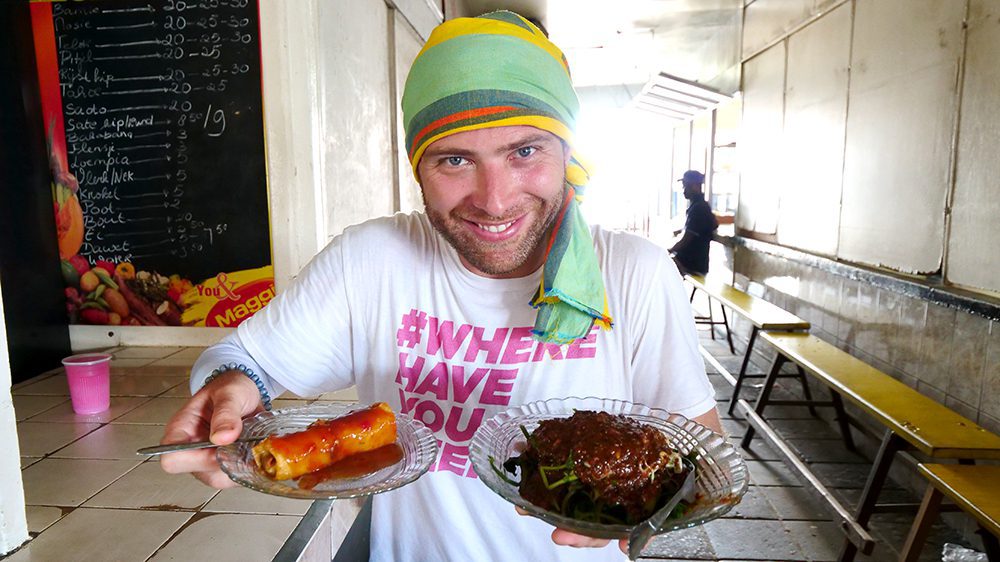
This beautiful blend can be seen everywhere in Suriname’s capital Paramaribo ( South America ), from its street markets to most restaurants. Add in the beautiful natural locations and lovely green space just minutes away and the wide range of accommodations available, and you have a city that’s ripe for curious tourists to explore, including the UNESCO World Heritage Site.
I explored the capital city Paramaribo with the help of Jenny’s Tours, who showed me an incredible time I will never forget. These are the top 15 things to do in paramaribo, Suriname ( South America ).
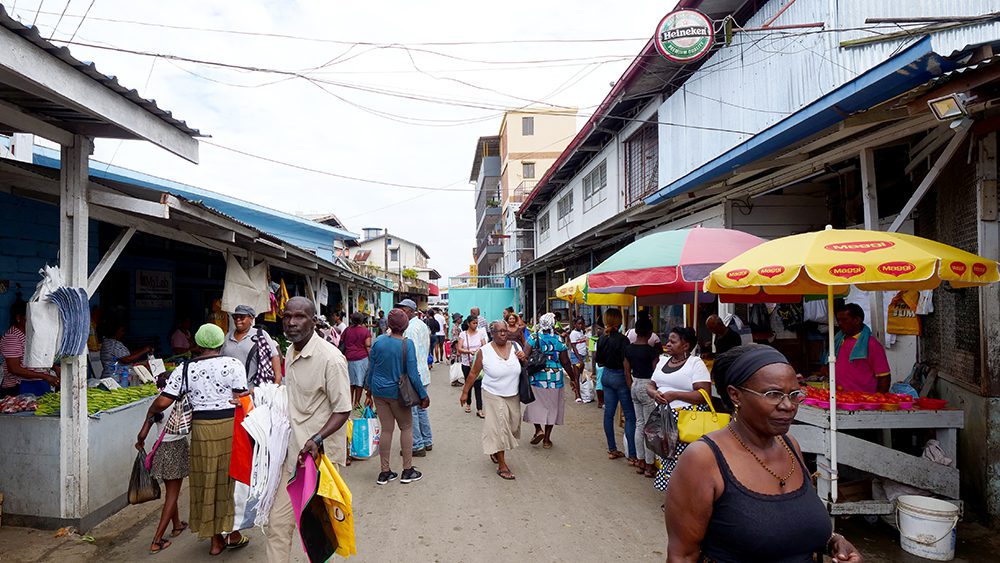
One of my favorite spots in suriname’s capital city Paramaribo is its Market. I visited just after 9 a.m. on a Saturday and immediately got a glimpse into daily life in the Surinamese capital city.
From the man mending broken shoes right on the street to the women selling lychee and other fresh produce as the aroma of fresh fish hung in the air, the market had everything I was looking for. My favorite thing about it is that I was the only foreign tourist, so I got to have a true, local experience.

Further along in the market are vendors selling lots of seafood, including dried and fresh shrimp, catfish roe, and lots of smoked catfish. The catfish has a rich, golden brown color that is extremely appetizing. And while it wasn’t my favorite, flavor-wise, it doesn’t contain any bones, which is always a plus!

One of the wildest sights in this area of the market is the crabs. These colorful crustaceans cling to the rim of metal barrels in the seafood area, and to each other. A long chain of crabs, just hanging out on the side of a barrel is a pretty unbelievable sight to see in this part of South America!

As you continue through the Market, you’ll come across the meat hall, where they butcher poultry on the right and fish on the left. The atmosphere immediately took me back to my time in Africa. It was fascinating to watch the butchers break down some of the freshest meat in Suriname. I recommend visiting and observing you’re not sensitive to this kind of thing. It was one of my favorite things to do in Paramaribo!

Past the butchers is the produce area, which reminded me of a wet market I visited in Manila. They had lots of vegetables I’d never seen before. I love finding new and fresh fruits, vegetables, and other foods when I travel. It’s one of the best parts of the experience!
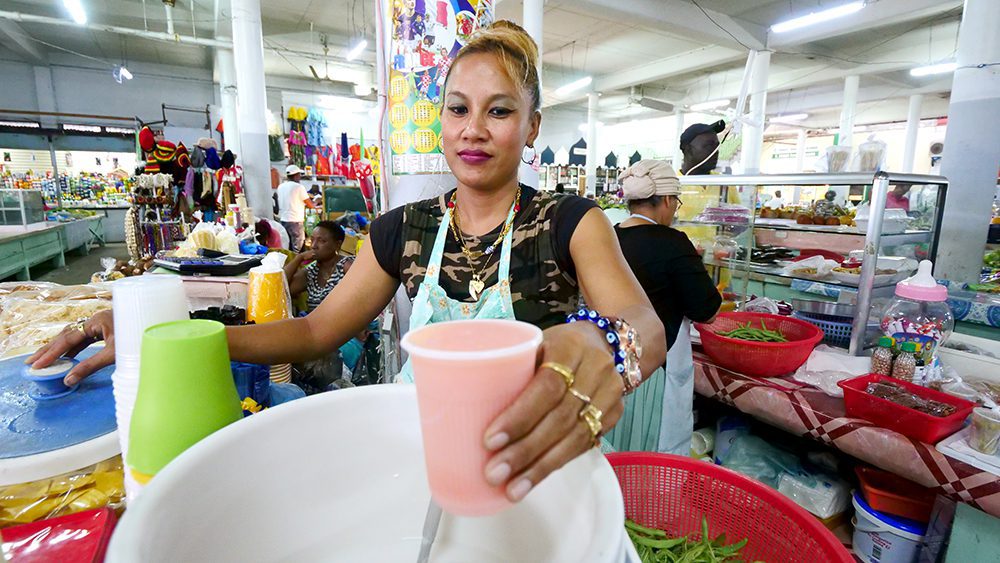
Finish off your visit to Central Market with a slush pom de citerre from one of the vendors. It’s essentially condensed rose milk with coconut, but you’ll need it as the temperature climbs. With Paramaribo as close to the equator as it is, the temperatures can get oppressive pretty fast, so you’ll need something refreshing and hydrating. It cost 6 SRD, or just under $1 USD.

NOTE: During my visit to Central Market, I came across quite a few people who did not like being filmed, but they were kind enough to let me get shots of their produce. When visiting the market, I recommend asking for permission before filming or taking photos of any of the people there.

For sure, one of the top paramaribo things to see and do is to get a taste of what a Surinamese breakfast is like. To do that, I recommend a stop at Cafetaria de Smaak along Van Sommelsdijck Street. This small but cozy eatery offers several dishes that are essentially protein salads that are meant to serve as the filling for sandwiches. The fillings include tiny shrimp, chicken, steak, fish, and potatoes with kidneys.
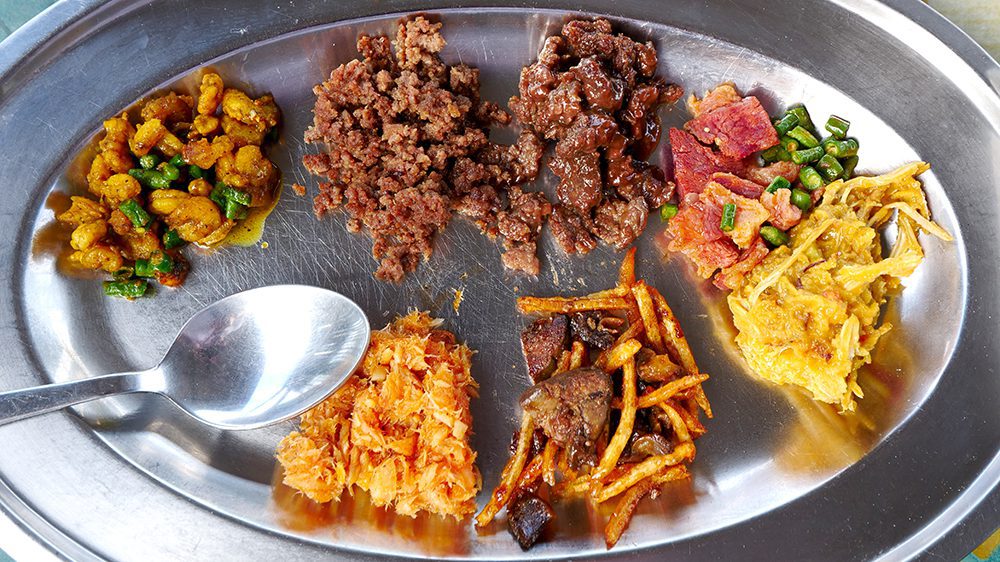
The way you take each item and try it with bread reminded me of the thalis I’ve tried all over India. They’re simple foods with simple ingredients, but have explosive flavors that make your palate go wild! I really enjoyed the shrimp curry and salty fish as well as the pom, which is a local chicken-salad-like dish with mango.

It had a soft texture and had a nice sweetness to it. The beef, meanwhile, was super tender and bathed in a rich sauce. I also recommend the potatoes and chicken kidneys if you love organ meat as much as I do!

I recommend trying everything separately at first and then mixing it all together to finish off your meal. Together, all of the different flavors and textures reminded me of something I’d eaten in Thailand. It’s a phenomenal meal and definitely one of the top things to see and do in Paramaribo. The best thing is, this breakfast will only set you back about $3 USD at the most!

When I travel, I love finding unique souvenirs to take home. I’m not really into items that have the country’s name splashed across them or commercially-made products. I’m much more of a local craft kind of guy. There’s nothing better than finding a one-of-a-kind, hand-crafted item that I can display proudly.

During my first day exploring Paramaribo, my guide Imro from Jenny Tours (a custom tours adventure) took me to the Suriname Riverside for a day trips history. There, you’ll find a quaint little craft market! The market is made up of Amerindian vendors selling brightly-colored clothing, decorative goods made from carved calabash shells including some intricate maracas. There was also quite a bit of jewelry, hats, handmade cloth bags, and more.
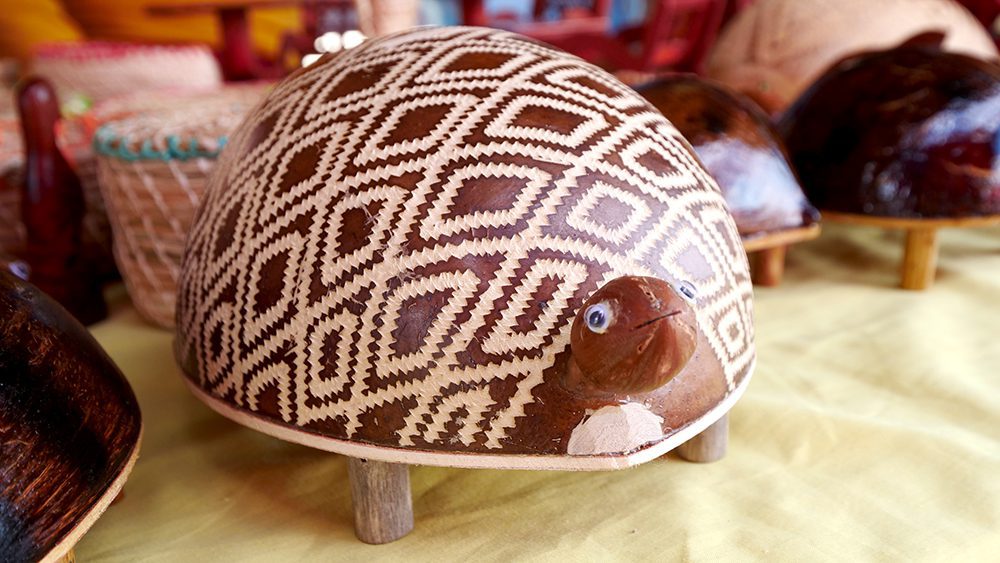
I found a cool turtle piggy bank made from a calabash shell for 50 SRD, or about $8 USD. The friendly vendor even gave me a free, hand-woven basket for being her first customer of the day! Don’t miss out on this craft market when you visit Suriname. Visiting is one of the best things to see and do in Paramaribo!

In Suriname, Sunday is market day. Several weekly markets pop up around the city early on Sunday mornings, and each offers its own unique peek into life in Paramaribo. One of my favorite things to see and do in Paramaribo is Chinese Market on Van Sommelsdijck Street.

This market, which opens at 6 a.m. every Sunday, is exactly as its name implies. There, you’ll find vendors under yellow tents selling various Chinese street foods including buns, dumplings, shumai, tofu, roasted duck, and meatballs. There are even vendors who sell Chinese interpretations of pizza and chorizo!
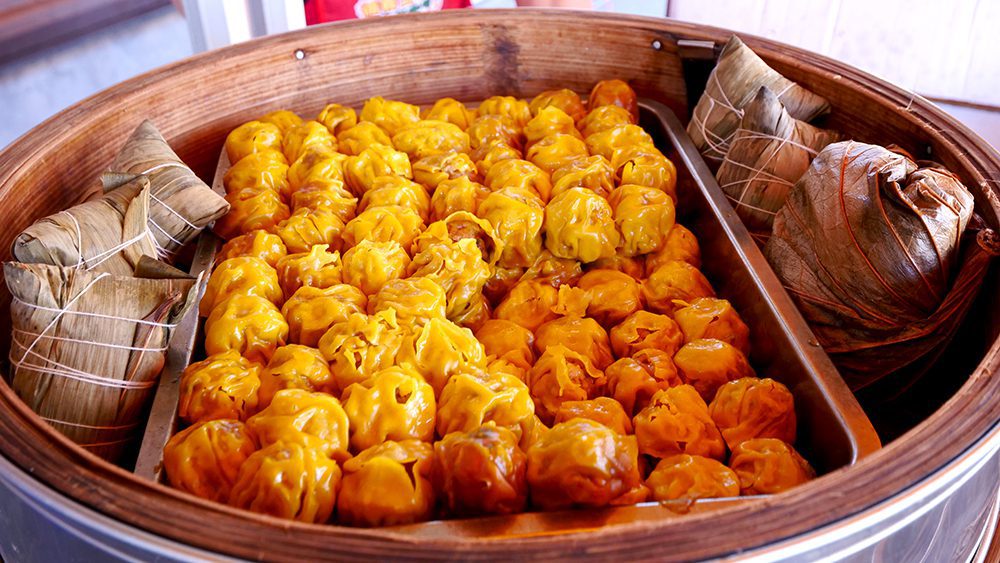
I cannot recommend the pork bun enough. During my first trip to China in 2015, I ate one of these sweet, juicy, and fluffy morsels every day for breakfast. Just one bite of the bun at Chinese Market took me right back to the time I spent wandering the food stalls along Huanghe Road in Shanghai with my father. You can’t beat the tenderness of the pork, the flavorful sauce, and the fluffy, flaky bun.

Speaking of being transported back to Shanghai, the pork shumai with soy sauce was incredible, as were the beef balls and chicken shumai! There’s also a fantastic chicken bun that is bursting with meat and a rich, red-orange sauce. As much as I love pork buns, this chicken bun had it beat!

Further along the street, you’ll also find vendors selling vegetables, including some I had never seen before. Another thing I had never seen before was a chorizo-like sausage coated in a delicious, Chinese sauce. The casing on it was tough, but the pork inside was fatty and tasty, like all pork should be! Wash it down with a cup of sweet and refreshing sugarcane juice. It’s the perfect way to end a street food tour of Chinese Market in Paramaribo.

Before you set off for the markets around town on Sunday mornings, take a quick detour to Independence Square. This peaceful recreational park and the area surrounding it is a great spot to get a good look at the city’s attractive Dutch colonial architecture. It’s bounded by some of the country’s most important buildings, visiting presidential palace, the Parliament, and the Ministry of Finance.

It’s also a popular spot for families, who often fly kites on the grass. But at 6:30 on Sunday mornings, Independence Square is home to local birdkeepers, who bring their pet birds to the square to show them off. The bird keepers set up their cages around the square for people to admire their small but beautiful birds. Once a year, a contest is held to see whose bird can whistle the longest!

Whether you visit Independence Square for the architecture, the chill surroundings, or the birds, it’s easily one of the best things to see and do in Paramaribo!

The list of things to see and do in Paramaribo on Sunday mornings continues with a visit to Saoenah Markt! This Indonesian food, produce, and clothing market is the biggest of its kind in Suriname. People from the island of Java came to work in workshops private of Suriname as indentured servants in the late 19th century, and they brought elements of their food and culture with them. These elements can be seen and tasted all over the market.

Almost immediately upon my arrival, I found a vendor making Indian vada, which is a savory, fried doughnut that’s served with various chutneys. You can also try dishes like stomach, fried banana, satay, lumpia, and more.

If you only try one thing at Saoenah Markt, make it the liver satay, which comes bathed in a rich peanut sauce. The iron-rich flavor of the dense liver, coupled with the sweet nuttiness of the peanut sauce blew my mind, and my taste buds, away!

You also can’t go wrong with the maduro-like fried banana with peanut sauce, and the vegetable lumpia with spicy ketchup. My three dishes came to just 15 SRD, or just under $2 USD.

Finish off your meal with a delicious drink made from coconut, rose milk juice, and small jellies. It’s a sweet and refreshing way to finish off yet another fantastic Surinamese street food experience!

I kid you not when I say that I tried the strongest alcohol of my life in Suriname! If you think you (and your liver) can handle it, take a trip to Lai Ghoon Bar, a Chinese-run establishment in town. It’s less of a bar and more of a liquor store.

There, you can try the Mariënburg rum, which is 90% rum and the strongest in Suriname! My guide Imro poured some in a cap and lit it on fire before we downed some. A word of warning: this rum is insanely strong!

It was insanely strong and brutal to get down. The second it hits your lips and tongue, it numbs your entire mouth. If you’re going to drink it, I recommend diluting it with water, but even then, it’s still extremely potent! It’s the strongest rum I’ve ever had in my life!

If you enjoyed your taste of Javanese food at Saoenah Markt, I suggest going all-in with a Javanese feast at one of the best eateries in the city, Jakarta Restaurant. Inside the restaurant is a mouthwatering buffet of never-ending Javanese fare. If you love good food like I do, eating there is one of the best things to see and do in Paramaribo.

I recommend starting light, with a soup or two. I sampled the saoto soup and a second soup that came with large, succulent jumbo shrimp. The saoto soup, which contained tofu, an egg, and sprouts, was served with a chili sauce and a thick and spicy soy sauce. The egg added a nice creaminess to the dish and took it to the next level!

At the buffet, I suggest going with the tender and juicy chicken satay, which was different from the version I once ate in Thailand. There’s also a tender beef with roasted coconut, bamboo shoots with sticky rice, coconut shavings with pepper, and some phenomenal fried tofu with sprouts, rice, and coconut.

The owner of the restaurant was extremely kind to me and kept sending me more dishes to try. He sent out a super tender steak, more jumbo shrimp, and a tasty fried rice called picante with a spicy and glaze-like hot sauce. They were all cooked to perfection and unbelievably tasty.

You must carve out a night to enjoy a meal at Jakarta Restaurant. There’s a reason why it’s one of the top things to see and do in Paramaribo! The food is exceptional and the service is out of this world! Tell them I sent you!

After a day of exploring a brand-new city, what better way to cap off your vibrant nightlife with a visit to a Brazilian block party? It’s no secret that Brazilians know how to party, and it’s hard to not join them as Latin rhythms ripple through the still, sultry air during a night in Paramaribo.

If you book with Jenny Tours like I did, your tour guide will take you to such a block party. There, you can watch Brazilian dancers perform, bust a move yourself, or just enjoy the vibes with some street food and a nice, cold Schin beer. Not much English is spoken there, but thankfully I was able to chat with the locals in Spanish.

But even if you find yourself lost in translation, checking out a Brazilian block party will likely be one of your favorite things to see and do in Paramaribo. I loved every minute of it and I’m sure you will, too!

If you’ve spent any time on my website or YouTube channel, you’ll probably know that I love Indian food. It’s one of my favorite cuisines in the world and I seek it out on an almost regular basis! One of the best things about my time in Suriname is that there is a significant Indian population there, so you can find delicious Indian food throughout the this beautiful country. One of my favorite Indian meals in Suriname was at Martin House of Indian Food.

When you take your seat at this spacious, open-air restaurant, I suggest starting with a piping hot cup of ginger chai. Chai is a milky, tea-based drink that is extremely popular throughout India. It’s one of my favorite things to have there! Having it is also one of the best things to see and do in Paramaribo. It’s creamy, frothy, and so tasty!

If you want to go all-out with your Indian feast, go with the non-veg thali. It comes with flaky aloo (potato) samosas, kachori, tandoori chicken, a layered rice dish called biryani, and fish curry. There’s also a non-melting cottage cheese called paneer, a flatbread called roti, and a sweet dessert called laddu.

The aloo samosa was actually sweet because of the addition of cardamom, while the kachori was like a Venezuelan arepa and contained raisins on the inside. Add the provided tamarind and mango chutneys to the samosa to give it even more of a sweet flavor! These chutneys are yet another reason why eating at Martin House of Indian Food is one of the best things to see and do in Paramaribo!

The carrots, peas, corn, and beans in the vegetarian biryani were fantastic. I tried some of the buttery and crispy fish curry with the biryani, which was an incredible flavor and texture combination in my mouth. You must try the fish curry with the roti. I usually prefer other Indian flatbreads like naan and parathas to rotis, but this one was divine and paired with everything on my plate perfectly.

One of my favorite Indian dishes is paneer. This variety contained peas, which I had never seen before, but it was so wonderful that I couldn’t help but go in for more bites of it. Try some of it alone, but then be sure to eat the rest as intended, with pieces of the roti. It’s spectacular!

One thing I learned throughout my travels in 2019 is what a difference it makes when chicken has been frozen and when it hasn’t. The chicken dishes I ate throughout my travels in Suriname were all quite different from one another, but they all had one thing in common. They had never been frozen, and you could taste the freshness in the meat. The tandoori chicken at Martin House of Indian Food was no exception. Always go for fresh, organic chicken when you can. It makes a huge difference!

For dessert, I had the laddu, which was a delicious, syrupy bread ball, and an insanely fresh mango lassi. Lassi is a thick yogurt drink that is extremely popular throughout India. It’s meant to be drunk at the end of meals to cool down your mouth from all of the spices from your main meal. It was made with fresh mangoes that were grown nearby!

If you want to try some of the very best Indian food in Suriname, you have to head over to Martin House of Indian Food. When it comes to things to see and do in Paramaribo, it should be near the top of everyone’s list.

Along the main road heading south from Paramaribo is the town of Lelydorp, Suriname’s second-largest city. This diverse town with significant Creole, East Indian, and European populations is largely Javanese, so it’s a great spot to find some Indonesian food.

My guide Jan from Jenny Tours took me to a Javanese food market in town where six vendors sell a wide array of food. There, you can try more exotic fare like kidneys and chicken feet, as well as tamer options like chicken, yuca, noodles, satay, fried banana, saoto soup, and much more.

The soy sauce and peanut dressing that coats the chicken satay makes it some of the best chicken I tried in Suriname! Meanwhile, veggie lovers will lose their minds over the lumpia and boiled vegetables, both of which are insanely tasty. The vegetables, which include spinach and sprouts, come with a magnificent peanut sauce that made my mouth water like crazy!

Meanwhile, the sprouts inside the lumpia added a bright freshness that provided a nice contrast with the doughy exterior.

You should enjoy your meal with some dawet, which is a floral and refreshing Indo drink made from coconut milk, lemongrass, and coconut meat. It tastes very tropical and helps make touring Lelydorp one of the top things to see and do in Paramaribo.

While you’re in the market, you can’t miss the chicken sausage. It came with a spicy, Indo-style sauce that added a real kick. The meat inside the sausage is which is so soft and tender that you can actually suck it out of the casing. It’s like a delightful, flavorful chicken mash and was the perfect kicker to a day exploring the other sights and flavors of Lelydorp!

If you find yourself in Paramaribo on Sunday, there is yet another market you’ll want to visit if you want to have a truly immersive experience. Kwatta Sunday Market seemed to be an all-purpose market, as you can buy vintage and secondhand clothing, fresh meat and produce, and yes, delicious street food.

The street food at Kwatta Sunday Market is a beautiful mix of practically every culture that can be found in Suriname. That means you could have a Chinese dish, a Javanese dish, and an Indian dessert all in the same meal! There are about eight or nine food vendors in total, so go nuts and then take a seat in the dining hall.

I highly recommend the national dish, which is barbecued chicken with brown beans and rice. The glaze-covered chicken reminded me of Indian tandoori chicken because of the charcoal flavor. It also seemed to have both Chinese and African influences, which made for an interesting and spicy flavor combination. I also loved the al dente beans!

If you love sweet rice dishes, you must try the ketan serundeng, which is an Indonesian dessert that contains coconut. I couldn’t get enough of this amazing tropical dish! There were also some magnificent fried balls made from yellow peas, as well as an airy and fluffy flour vada with a spicy pepper chutney. Don’t miss the bojo, a Jewish cake that is made from grated casaba and coconut and is flavored with rum!

For dessert, I went for the very first Indian dish I ever tried in India, jalebi. This syrupy, deep-fried, orange dough spiral was every bit as amazing as it was when I first tried it in Chandni Chowk in Delhi.

After you eat, wander around the suriname’s capital city market to see what you find. There’s a fish market there that is absolute sensory overload between the smell of fresh fish and the sight of butchers quickly breaking them down in front of your eyes. You can also find fresh chicken, shrimp, and venison in the market. Meat markets are always a raw but amazing look into the local history and culture. It’s an authentic experience, for sure!
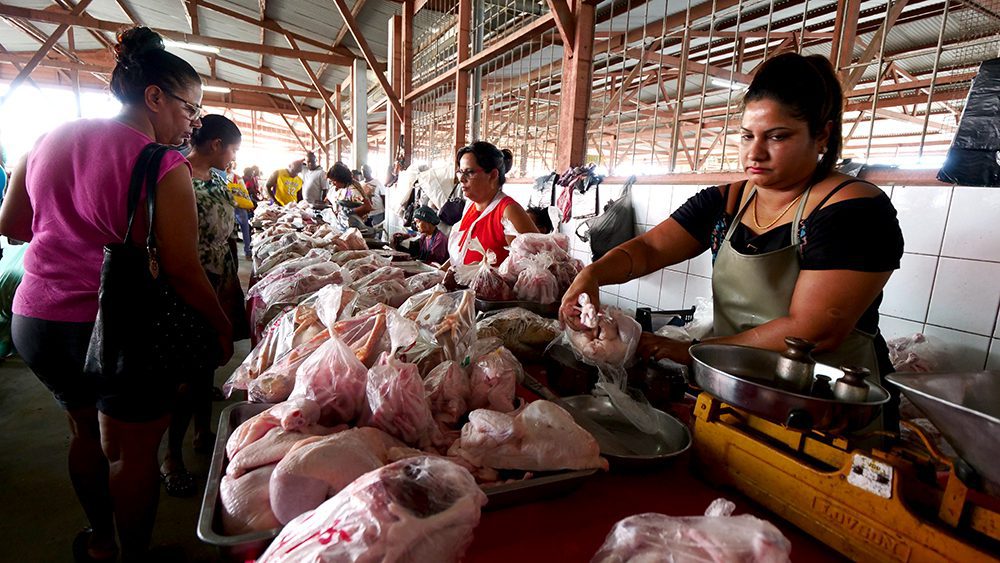
As my time in Kwatta Sunday Market concluded, I came across a barbershop. I didn’t go inside because I was pressed for time, even though I needed a trim. You can also find vendor selling everything from fresh ginger beer to CDs to jars of homemade mango chutney! This market is one of the top things to see and do in Paramaribo and one of the best times you’ll have in Suriname!
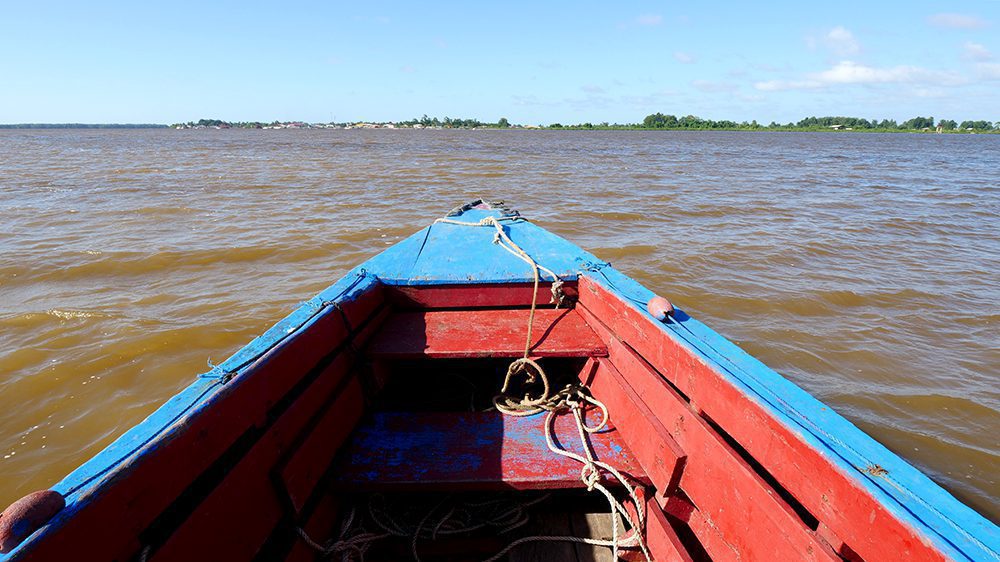
On the right bank of the Suriname River, you’ll find Johanna-Margaretha, a municipality in the Commewijne District. The municipality can be found near the spot where the Suriname and Commewijne Rivers meet. It is these waterways that provide two of the greatest adventures you can have in Paramaribo.

If you head out to explore this area at sunset with Jenny Tours, you’ll find yourself at the confluence of the two rivers. This area is usually rough during low tide. I visited at high tide when the waters are calmer. The calmer waters give you a much better opportunity to observe what’s happening on the water’s surface. Before long, you should be able to spot one: a small, sleek, torpedo-like shape that explodes from the water, soars several feet and then submerges itself again.

Yes, the confluence of the Suriname and Commewijne Rivers is home to dolphins. More technically, they’re Guiana dolphins, one of the smallest dolphin species in the world,. They’re noted for their pink bellies, and some of them are pink all over!

My guide, Roël, told me that these dolphins are usually pretty shy and don’t like to get too close to boats, but they certainly put on a show for us as at least a dozen of them played and danced across the gentle surf. It was a real treat for me. I had only seen a dolphin in the wild once before, so watching these playful creatures leap into the air is something I’ll never forget.
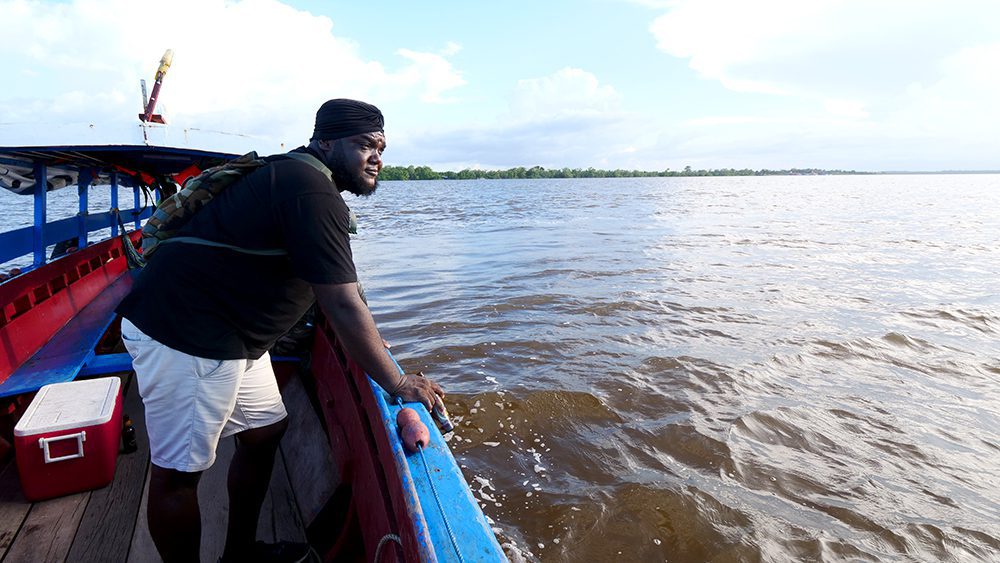
It was one of my absolute favorite things to see and do in Paramaribo and I hope you get to experience it as well.

After you’ve watched the dolphins for about an hour, your guide will then turn down a canal branching off from the Commewijne River. As I admired my surroundings, I felt as though I had been teleported halfway across the world to Goa or Kerala in India. It looked almost exactly like photos I had seen of the Kerala backwaters!

Eventually, you will land at the Johanna en Margaretha Plantation. This former Dutch plantation, which has a long and sad history, is now owned by a friendly and hospitable family. You’ll get to meet them and then taste some of their outstanding food!

As someone who is in love with Indian food, I was in heaven in Suriname. The meal that was placed in front of me consisted of roti, aloo with greens, and chicken curry. It was everything I love about Indian food. Not only was it tasty and homemade, but you could tell it was also made with love. Indian hospitality is amazing and it seemed they had brought it over to Paramaribo!

The hot roti was so tasty with the chicken curry, which was coated in a mouthwatering masala. For some reason, fresh, organic chicken always has lots of tiny bones in it, so be extra careful as you’re eating so you don’t swallow one. The aloo, or potato, with greens was also really wonderful, especially with the hot sauce that Roël gave me. Having this meal is one of the top things to see and do in Paramaribo, for sure!

Your exploration of Johanna-Margaretha with Jenny Tours is not over after you finish your meal. Once you finish eating, you’ll get to chill at the plantation for a while until the sun goes down. It needs to be pitch-black for your next activity interest tours with free cancellation, searching for caimans in the nearby mangrove swamps!

The caimans don’t come out until after sundown, so it’s pitch black in the swamps at that time. Roël donned a head lamp and took me on a boat ride further down the canal, looking for the reflection of eyes in the spotlight. At one point, you’ll have to lie flat in the boat as you pass beneath a very low bridge.

If you’re lucky, your guide may even catch a couple of caimans! As we explored, we spotted three caimans in total. One of them got away from us, but Roël was able to snare the other two and bring them onboard so I could see them better. The first of the two was about 15 inches long and really beautiful and calm as I held him in my hands. The second of the two was almost three feet long and had some fight in him!

As roughly 80% of Suriname is covered by rainforest, it should come as no surprise that there are a lot of mosquitoes in the country, especially in the wilderness. The mosquitoes in the mangrove swamps near Johanna-Margaretha are relentless, so I recommend using a high-quality insect repellent like OFF! Deep Woods before you head out there for your quad tour. I ran out during my trip and had to settle for a local brand, which did not work well at all. Make sure you buy enough for the entirety of your Suriname vacation!

I visited Suriname in July of 2019, the hottest part of the year. The days start out hot and only get more sweltering as the day wears on. Because of that, one of the best things to see and do in Paramaribo is to enjoy a nice, cold beer during the day! One of the best spots to pick one up is Suriname Supermarket, where they sell four types of Atlas beers.

Atlas Beers are from the Netherlands are incredibly strong! The four varieties had alcohol content levels of 8.5%, 12%, 14%, and 16%! There was no way I could pass up the opportunity to sample the Mega Strong, which was the most potent at 16% alcohol. It cost 16 SRD or about $2 USD.

When I say this beer will put some hair on your chest, I mean it. Even sipping it is an intense experience! It was so strong that my guide Imro and I wound up sharing it. I recommend splitting it with friends when you come to Paramaribo. It’s way too strong otherwise and will have you messed up for the rest of the day!
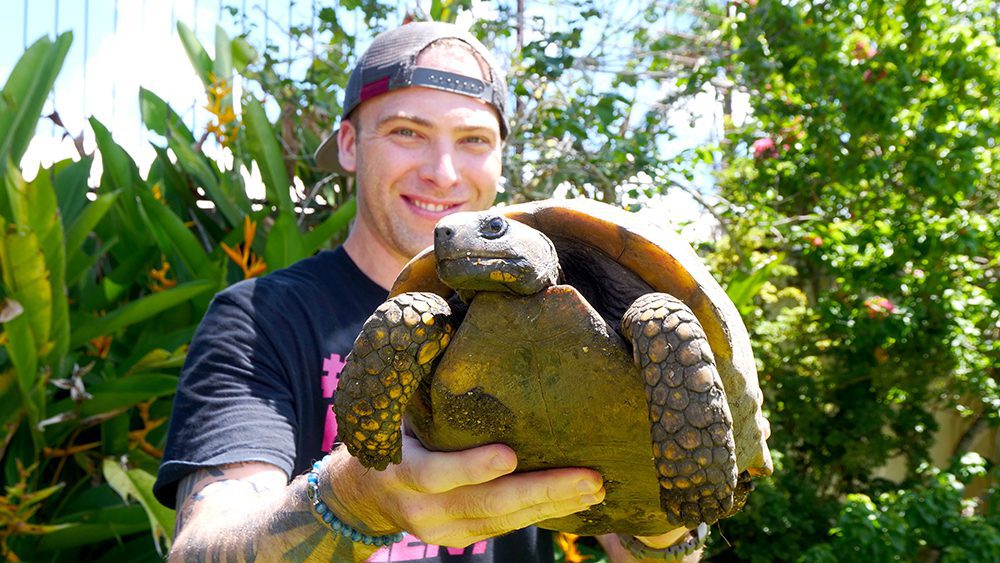
Of course, when you visit Paramaribo, you’ll need a place to keep your things and lay your head at night. I tried a few different accommodations there that ranged from very basic and minimal to ultra-lux, so I want to tell you about my two favorites.

If you’re traveling on a budget, you can’t get much better than the Downtown Oasis Guest House. This massive house and its grounds are home to a pool, gazebo, four hotel-style rooms, four apartments, and even a small turtle sanctuary. Located in the heart of downtown Paramaribo, the complex is safe and centrally located, so you don’t have to travel far to get anywhere in town.

My apartment was spacious and contained two bedrooms, a small living room with two couches and a TV, a dining room table, and a sleek, modern kitchen. Pots, cups, and utensils are provided in the cabinets. There’s also air conditioning, which is essential for combating the Surinamese heat!

You can also grab a beer from the fridge in the gazebo on the grounds, and go hang out with some of the local yellow-foot tortoises. If you like a nice, quiet space and don’t want to spend an arm and a leg, staying at the Downtown Oasis is for you!

On the higher end, if you have money to burn, you may want to go the more upscale route and book a room at the Royal Torarica, the best and most exclusive hotel in the entire country! This posh, swanky, four-star hotel has 105 beautiful, modern rooms with all the amenities you could ever want or ask for. The hotel boasts stunning glass elevators, wonderful hospitality, high-speed internet, and even a peaceful botanical garden.

Outside, the hotel is even more stunning, as there is a gorgeous pool area where you can kick back and relax or take a dip in its waters! Everything at the Royal Torarica, from its carefully manicured lawns to its upscale dining experiences, is designed to give each guest a high level of luxury and comfort. It’s like an exclusive boutique hotel right in the middle of Paramaribo!

If you enjoy the finer things in life, staying here is one of the top 15 things to see and do in Paramaribo!

There are so many outstanding things to see and do in Paramaribo that I couldn’t just stop at 15 entries, especially when I haven’t talked about Souposo yet! This award-winning soup café has a fantastic atmosphere, with outdoor seating on a partially-covered garden terrace. offers a wide variety of dishes from around the world.

I highly recommend trying their two signature soups, the African-influenced Crunchy Pinda, and the Javanese Saoto Soup. The Crunchy Pinda is phenomenal. It’s a creamy, peanut buttery soup with chicken that goes extremely well with either bread or rice. It’s almost like straight peanut butter and was so tasty I couldn’t stop eating it!

The soups come with hot sauce, diced chilies, bread, and rice. If you like your soups to have more of a kick of heat, you can add spicy soy sauce or cayenne and chilies. I was told that they were really hot, but I could handle them!

The Saoto Soup is a thinner soup with a clear broth. It contains an egg and lots of crunchy sprouts and onions. The egg in the soup had a different flavor than I was used to, but I really enjoyed it along with the Indo flavors throughout. Adding the spicy soy sauce made an already great soup fantastic!

I also must give a shout-out to the amazing staff at Souposo. They’re very kind and friendly. My waitress, Soitsjka, even brought me brought me a sampler of the soup of the day for free. It was a creamy, vegetarian soup that contained brown kidney beans. Like the previous two soups, it was quite tasty and had my taste buds clamoring for more!
Paramaribo is unlike any other city on Earth. Nowhere else have I seen so much diversity and so many people of wildly different backgrounds co-existing so harmoniously. That harmony has created a unique culture that is rife with friendliness and amazing hospitality, and one that has produced exquisite, cosmopolitan cuisine. Whether you’re exploring its markets, its restaurants, or its plantations, it’s always on full display. This is a city you need to experience for yourself. Book a trip to Paramaribo today to get a taste of everything Suriname has to offer!

NOTE: If you need to check the visa requirements of a particular country, click here. To apply for a visa, find up-to-date visa information for different countries, and calculate the cost of a particular visa, click here!
Counter
101 Countries • 1432 Cities